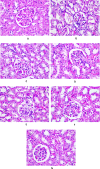Hesperetin and Isoliquiritigenin Attenuate the Progression of Diabetic Nephropathy via Inhibition of NF-κB/NLRP3 Pathways in Type 2 Diabetic Rats
- PMID: 40821511
- PMCID: PMC12355235
- DOI: 10.1021/acsomega.5c02026
Hesperetin and Isoliquiritigenin Attenuate the Progression of Diabetic Nephropathy via Inhibition of NF-κB/NLRP3 Pathways in Type 2 Diabetic Rats
Abstract
Glucose toxicity associated with oxidant and inflammatory triggers causes diabetic nephropathy (DN), thus necessitating the investigation of potential therapeutic interventions. This study investigated the nephroprotective activities of hesperetin (HSP) and isoliquiritigenin (ISL) in diabetic rats. Type 2 diabetes (T2D) was generated in Wistar rats by feeding them a high-fat diet (HFD, ad libitum) and injecting intraperitoneally with a single dose of streptozotocin (35 mg/kg). T2D rats were then administered orally HSP (50 and 100 mg/kg), ISL (10 and 20 mg/kg), and metformin (180 mg/kg) for 4 weeks along with the continuous feeding of HFD. The study assessed various renal function parameters, including kidney index, kidney inflammatory biomarkers, kidney oxidative stress biomarkers, fasting blood glucose, serum insulin, serum lipids, blood urea nitrogen, serum creatinine, urine protein, creatinine clearance, protein/creatinine ratio, renal histopathology, and relative gene expressions of kidney NLRP3 and NF-κB proteins, comparing these parameters with normal and diabetic control groups. The findings indicated that HSP and ISL attenuated the pathological progression of DN, as demonstrated through the normalization of various biochemical and gene expression biomarkers, indicating a marked anti-inflammatory and antioxidant effect, improved kidney histology, and mitigated renal dysfunction. These findings suggest that HSP and ISL exhibit nephroprotective effects via mechanisms including inhibition of NLRP3 and NF-κB activation, decrease in oxidative stress, and improvement of the blood glucose status of T2D rats.
© 2025 The Authors. Published by American Chemical Society.
Figures






Similar articles
-
Study on the modulation of kidney and liver function of rats with diabetic nephropathy by Huidouba through metabolomics.J Ethnopharmacol. 2025 Jul 24;351:120136. doi: 10.1016/j.jep.2025.120136. Epub 2025 Jun 11. J Ethnopharmacol. 2025. PMID: 40513925
-
Renal protection by acacetin in streptozotocin-induced diabetic nephropathy via TLR4/NF-κB pathway modulation in rats.Adv Clin Exp Med. 2025 Aug;34(8):1353-1363. doi: 10.17219/acem/192225. Adv Clin Exp Med. 2025. PMID: 39749747
-
Micheliolide mitigates diabetic nephropathy by modulating oxidative stress and inflammation in rats.Phytomedicine. 2025 Sep;145:157025. doi: 10.1016/j.phymed.2025.157025. Epub 2025 Jul 2. Phytomedicine. 2025. PMID: 40712283
-
Effective dose/duration of natural flavonoid quercetin for treatment of diabetic nephropathy: A systematic review and meta-analysis of rodent data.Phytomedicine. 2022 Oct;105:154348. doi: 10.1016/j.phymed.2022.154348. Epub 2022 Jul 19. Phytomedicine. 2022. PMID: 35908521
-
NTP Developmental and Reproductive Toxicity Technical Report on the Prenatal Development Studies of 2-((1-(4-Phenoxyphenoxy)propan-2-yl)oxy)pyridine (CASRN 95737-68-1) in Sprague Dawley (Hsd:Sprague Dawley® SD®) Rats and New Zealand White (Hra:NZW SPF) Rabbits: DART Report 07 [Internet].Research Triangle Park (NC): National Toxicology Program; 2022 Jan. Research Triangle Park (NC): National Toxicology Program; 2022 Jan. PMID: 35593777 Free Books & Documents. Review.
References
-
- Khanra R., Bhattacharjee N., Dua T. K., Nandy A., Saha A., Kalita J., Manna P., Dewanjee S.. Taraxerol, a pentacyclic triterpenoid, from Abroma augusta leaf attenuates diabetic nephropathy in type 2 diabetic rats. Biomed. Pharmacother. 2017;94:726–741. doi: 10.1016/j.biopha.2017.07.112. - DOI - PubMed
LinkOut - more resources
Full Text Sources
